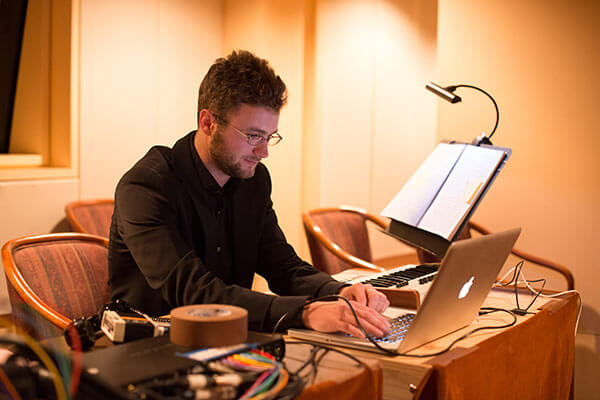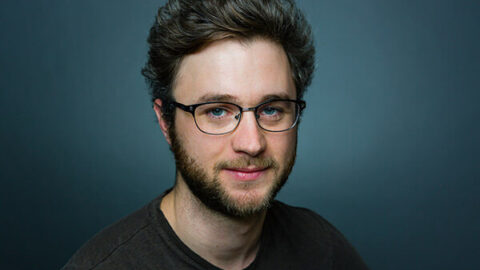On Saturday, November 8, the San Francisco Symphony (Michael Tilson Thomas, conductor) will perform Samuel Adams’s Drift and Providence, a 19-minute orchestral piece co-commissioned by the San Francisco Symphony and the New World Symphony, and funded in part by the Composer Assistance Program of New Music USA. We talked to Adams about it.
Getting to work with the San Francisco Symphony and Michael Tilson Thomas must be extremely exciting and a huge feather in your cap. What were some of the challenges you faced, both internally and externally, when writing Drift and Providence for the San Francisco Symphony and New World Symphony?
Yes, it is a privilege working with this wonderful group of musicians. I am so glad that MTT, the San Francisco Symphony, and New World prioritize the support of young artists.
The project’s genesis was through New World Symphony directly. Each year, the organization curates an evening of new work. In 2012, I was asked to create a piece to be presented alongside the work of composers Marcos Balter, Amy Beth Kirsten, poet Malachi Black, and visual artist James Nares.
Because New World is housed in one of the world’s most advanced concert halls, I thought it would be compelling to create a piece that would exploit the technologies of the interior—those being the modular arrangements of the musicians and the discrete spatialization and amplification of electronic sound. For the premiere in Miami, I had the percussionists on ‘satellite’ stages, and their sound was amplified and distributed throughout the space.
The main ‘external’ challenge was to push the technology without stifling the orchestra’s ability to sound their best. The piece, above all else, is an orchestral work, and the last thing I wanted was a composition that renders the players secondary to the technology.
The main ‘internal’ challenge writing this piece was the same challenge I encounter with every piece: finding a way to make music that sounds self-evident and inevitable—where each event is heard as the only possible event that could happen in a particular moment. For me, this is the most interesting and challenging part of composing. I think it is an unsolvable task, which is great.
You’ve been lucky enough to have lived in two very different US cities for a time, New York City and [San Francisco] Oakland, California. How would you compare the music scenes in these cities and what are the styles in new music that are prevailing in both?
I find it difficult to make generalizations between music scenes. What I can say, however, is that New York City and the San Francisco Bay Area both have healthy and diverse artistic ecologies—many people making art in many different ways.

It seems in recent years that electronics have finally started to be more accepted into orchestras and other large ensembles, especially some of Mason Bates’ pieces with the Chicago Symphony and the piece you’re taking on tour with San Francisco. How do you add electronics into your orchestration thought process and where do you see the merge of electronics in orchestras going from here?
The tradition of employing electronics into large ensemble music goes back to the middle of the 20th century with works like Edgar Varèse’s Déserts and Karlheinz Stockhausen’s Mixtur and all the way through recent decades with pieces like Mark Andre’s Üg and Kaija Saariaho’s Lichtbogen. But it is true that American orchestras perform these kinds of works only on rare occasion.
I most often employ electronics in very subtle ways. For Drift and Providence, the electronic component is simple and unobtrusive: I place digital resonators on the percussion section, select and amplify pitches from a metallic noise texture, and attenuate the non-harmonic frequencies. Effectively, the computer only enhances what already exists on stage—so I think of myself more as a sound-designer and less as a performer.
As for the future of electronics in performance, I think the question is really about physicality. I find it visually uninteresting to watch someone perform on a laptop or press buttons on a MIDI controller. My hope is for more dynamic forms of interfacing between humans and computers, so that a complex digital sound is mirrored by a complex human gesture—so that watching a performance of an electroacoustic work is as fragile and unpredictable as watching a violinist play a Bach Partita.
There seem to be so many influences present in your music. Who or what are some of the influences that you draw on and hear in your works?
Like most composers of my generation, my influences are far-reaching. As for contemporary musicians, I love the music of composer/saxophonist Steve Lehman and sound-artists Stephen Vitiello and Ryoji Ikeda. In the last couple of months, I have been getting into the fascinating worlds of Rashad Becker and multidisciplinary artist eRikm. I also find inspiration in the music of my friends Adrian Knight, Chris Cerrone, and Ingram Marshall.
Aside from that, I enjoy working with dancers. In the last two years, I have had the opportunity to work with two very imaginative choreographers, Jennifer Harrison Newman and Robert Dekkers. They have taught me to listen to music in a very different, almost holistic way.
Your upcoming projects are being written for piano greats like Emanuel Ax. How are you planning on using the instrument and the capabilities of these players?
Yes, I am so lucky to be faced with the challenge of writing pieces for three wonderful and very different pianists: David Fung, Sarah Cahill, and Emanuel Ax. I am thinking of each piece as the beginning of one larger endeavor—a collection of works like Maurice Ravel’s ‘Miroirs’ or Morton Feldman’s Piano Pieces. My plan so far is to write to what I know about each player’s uniqueness, and, hopefully, by doing that, I can create several interesting and varied works.
For tickets and more information, visit: the San Francisco Symphony Event Page.
























